A discussion of local wild Passion Flowers can be easy or difficult. On the easy side only two have fruit worth eating and only one has leaves that humans can consume. On the difficult side there are about a dozen species of local Passion Flowers. If you count cultivars there are over 40 Passion Flowers worldwide. Most of the man-made cultivars if not all are used for fruit production. One has edible old roots.
The main problem seems to be that all but one species of Passiflora has some cyanide in its leaves. How much, is cyanide really in all of them save for one, and can processing get rid of the cyanide are foggy issues. And what is interesting is that the one species that definitely does have edible leaves — no cyanide — has a significant neurotransmitter, that is, a chemical that can act positively in the brain… as if it gave up deadly for helpful. (I have excluded P. edulis from this discussion because it is grown commercially grow with an edible. It’s the Passion Flower found in Hawaiian Punch.)
Perhaps the most common Passion Flower locally is Passiflora incarnata. I saw hundreds of them in bloom today while riding a bike trail between Lake Monroe Park and Gemini Springs Park in Volusia County, Florida. The young plant looks shrubby growing upright until weight pulls it over revealing the vine that it is. It can grow 100 feet or so and is always producing new fruit on the growing end (and ripening fruit futher back.) For our purposes the fruit is in two stages, green and unripe, yellow and ripe. A little of the green fruit can be nibbled raw and any sweet and sour seeds with arils that you find inside are also edible. You can slice up the green fruit and fry it like a green tomato. The yellow ripe fruit is edible as is but is more esteemed for the sweet and sour seeds and arils inside (yes, you eat the aril and the seeds.) If you eat all of several ripe, yellow fruits raw they can irritate your mouth.
The second edible species I see often but more in the southern part of the state is P. foetida. Its thin-skinned bright red fruit including seeds and arils are also edible. Yes, you can eat the red skin as well. It’s smaller than P. incarnata, about ping pong ball size. A third edible species but of only so-so flavor is P. lutea. It looks better than it tastes. P. lutea is fairly easy to identify with its broad leaves and dark blue/purple fruit. It usually grow in damp places. P. lutea is surprisingly common but not a great addition to the foraging menu.
The only species I know for certain that does not have some cyanide in its leaves and thus can be eaten cooked is the P. incarnata, the more common one we have. However, the leaves do smell like rubber gym shoes. In the place of cyanide, so to speak, the species has GABA, or gamma-Aminobutric acid, which calms the brain, that is, it is “an amino acid that acts to inhibit the transmission of neve impulses in the central nervous system.” GABA a common supplement. All the above ground parts of the P. incarnata are dried, powdered and are widely-used as a sedative in Europe. If you cook the leaves the GABA is in the cooking water. The plant’s leaves are also dried and smoked for their calming effect.
Ornamental Passion Flowers have been bred to not have fruit. They also probably have a lot of cyanide in their leaves so leave them alone. The read about the Passion Flower go here.
Coccinia grandis — Ivy Gourd, Tindora, Tindori — is an escaped vegetable I eat nearly every day. They also make good pickles. It was first recorded in Florida in 1908 which is also about the same time the dreaded Air Potato was intentionally introduced for testing. Ivy Gourd is viewed as a noxious weed but I really have to traipse around to find it. The species is not everywhere like the Air Potato. I know of it growing locally in four places. Ivy Gourd is reported sporadically from extreme western Florida to extreme southern Florida. It’s also considered an obnoxious weed in Hawaii and in Australia (Only well-fed places call an edible wild plant an obnoxious weed.) Once found Ivy Gourd not difficult to identify. Usually located on a study fence or a thick ground cover, it looks like an ivy with stubby cucumbers that turn from green to bright red. While Ivy Gourd can fruit all year it bears heavily in the late spring. What is remarkable about the species is that it seems to be nearly disease free. For a few weeks the green fruit can have a larva in it but that is easily cut out and the rest eaten… or you can eat the larva. That minor infestation seems to go away as soon as the hot weather hits. Other than that nothing seems to bother the plant — read the fungus that bothers tomatoes and cucumbers et cetera doesn’t infect it. Young shoots and leaves are also edible (and used to treat high blood pressure.) And if I remember correctly the roots have been eaten to help control diabetes. There are actually two edible species, the aforementioned and a bitter variety. I have never found the bitter kind. As Ivy Gourd grow perennially from a root light freezes also don’t bother it. It can also be safely eaten by goats, sheep, cattle, donkeys and camels. You can read more about it here.
Sibara virginia is a little mustard I don’t write about too often because I just don’t see it too often. It’s a kind of post season after thought found under your feet. I do believe, however, that I found some on a large pile of dirt this past weekend. Where that pile of dirt came from is a good guess. You will note if you spell Sibara backwards you get Arabis and the plant has been called Arabis virginica. Why? I think the story behind that is the plant was originally thought to be in the Arabis genus from the Middle East. It was called Arabis virginica until someone decided the species is actually native to North America and not an Arabis. The solution… reverse the name, Arabis to Sibara. In botany circles that is called creative and clever. Sibara is found in “disturbed” sites and I usually find it in the spring not other times of years. Like all mustards, it is edible raw or cooked. Read about it and other little mustards here.
FORAGING CLASSES: Some of the highlights of this week’s foraging class in Wickham Park in Melbourne will be the Tallow Plum — tasty — and the Water Hemlock — very deadly.
Saturday, May 13th, Wickham Park: 2500 Parkway Drive, Melbourne, FL 32935-2335. 9 a.m. Meet at the “dog park” inside the park (turn right after entrance, go 1/4 mile, dog run on right, parking at run or on previous left.)
Saturday, May 20th, Dreher Park, 1200 Southern Blvd., West Palm Beach, 33405. We meet just north of the science center in the northern part of the park. 9 a.m.
Saturday, May 27th, Boulware Springs Park, 3420 SE 15th St., Gainesville, FL 32641. 9 a.m. Meet next to the spring house.
To read more about the foraging classes go here.
Want to identify a plant? Looking for a foraging reference? Do you have a UFO, an Unidentified Flowering Object you want identified? On the Green Deane Forum we chat about foraging all year. And it’s not just about warm-weather plants or just North American flora. Many nations around the world share common weeds so there’s a lot to talk about. There’s also more than weeds. The reference section has information for foraging around the world. There are also articles on food preservation, and forgotten skills from making bows to fermenting food. One special section is “From the Frightening Mail Bag” where we learn from people’s mistakes. You can join the forum by clicking on the button on the upper right hand side of this page.
Spring orders have started their annual increase. All of Green Dane’s videos available for free on You Tube. They do have ads on them so every time you watch a Green Deane video I get a quarter of one cent. Four views, one cent. Not exactly a large money-maker but it helps pays for this newsletter. If you want to see the videos without ads and some in slightly better quality you can order the DVD set. It is nine DVDs with 15 videos on each. Many people want their own copy of the videos or they have a slow service and its easier to order then to watch them on-line. They make a good gift for that forager you know. Individual DVDs can also be ordered. You can order them by clicking on the button on the top right of this page or you can go here.
From the Archive: Is all Seaweed edible? No, but most of them are. Two non-edibles one might encounter in North America are Desmarestia ligulata (Flattened Acid Kelp, photo right) particularly found on the northwest coast, and Cyanobacteria (blue-green algae) found in the Caribbean and linked to ciguarera poisoning. D. ligulata accumulates hydrochloric acid, making it non-edible. However, they do use the acid for pickling. As for the alga it is why one is not supposed to eat barracuda any longer than your forearm. They think the fish collects some chemical in the alga making it toxic when an adult. So if in warm seas, avoid blue-green blobs and if in cold water and a seaweed burns you, have D. ligulata. There might be some toxic red seaweed in the Southseas as well. But other than those two mentioned the seaweed found around North America should be edible.
Since most seaweed is edible, and nutritious, why isn’t it consumed more often? Taste and texture. I’ve collected Sargassum here in Florida and entertained several ways to prepare it. Semi-drying and frying isn’t too bad but… Bladderwrack is better, Sea Lettuce better still and I think easy to find. Not surprisingly most land animals including birds don’t like seaweed. However, it does make good mulch and fertilizer. So while one may not use it directly in the diet it can still help sustain you with uses in the garden. Here are some of my articles on seaweed: Bladderwrack, Caulpera, Codium, Gracilaria, Sargassum, Sea Lettuce, and Tape seagrass.
This is issue 256
If you would like to donate to Eat The Weeds please click here.

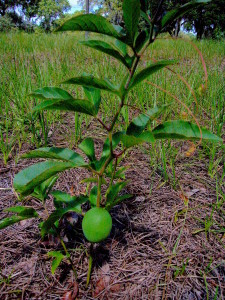
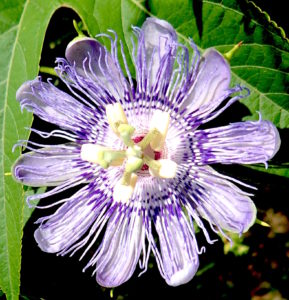



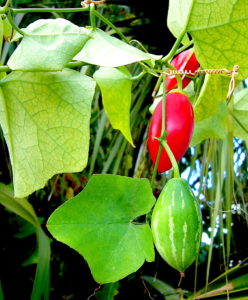
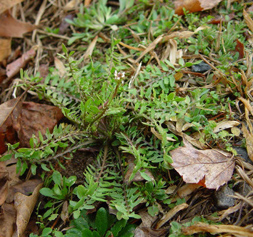
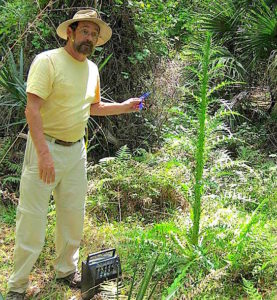
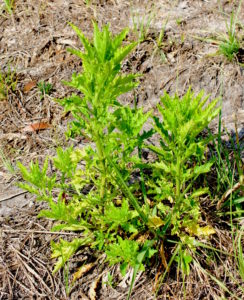

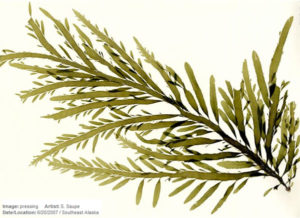
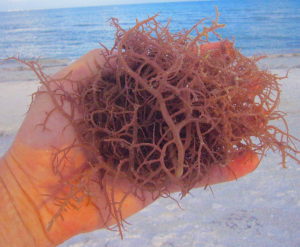

Just bought a Tindora cutting from Grower Jim.
It is of great interest to know about how useful P. Incarnata with respect to the neurotransmitter Gaba. Indeed I know of a freind who has been advised medically to take capsules of Gaba. Further, l’ve known that a deravative of Gaba called pregabalin ( or Gabica ) has been synthesized and at present available in pharmacies. The point of more interest and worth of meditation is as you’ve mentioned compensating gift for risk. Many thanks for the useful info.
Thank you for covering Gaba and Passion Flowers Types. The most effective muscle spasm remedy that was ever suggested to me is a Passion Flower Extract. Could this be why? For years I had very strong night cramps in my calves. A local Herbologist suggested Passion Flower Extract. It worked better than any other remedy ever offered. It also gives a great sleep.
PS: The Passion Flowers that grow here are Golden Fruit with a red mulberry type fruit inside. They are supposed to be Incarnata.
Hi,
Fantastic newsletter….just a small correction, there are more than 150 known passion flower species not 40!
Cheers
Carlos
DREAMFRUTAS
Cornucopia II only lists about 40, not counting discontinued and duplicate names.